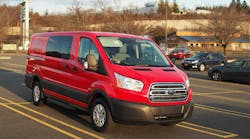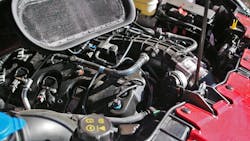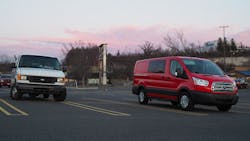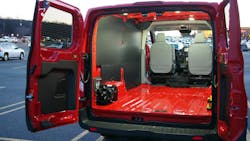If you think of it as a new hire, the Ford Transit might be like those capable hard workers that can endear themselves to you before long.
During a week's stint in a 2016 Transit 150, the van proved comfortable, well-built and a solid performer — and within a few days, I'd already nicknamed our test vehicle "Big Red" and actually did enjoy driving it. That's saying a lot for a guy who normally drives passenger cars, not work vans and trucks.
Let's be clear, though: We didn't test (and won't make judgments about) the Transit as a cargo van to be outfitted for business use day in and day out. That's your job. But in that regard, the Transit should have lots of potential as a canvas on which to paint, offering a host of customization options and thoughtful features to allow upfitting for whatever you might need a van to do.
We did, however, drive the Transit exclusively for a week on everything from some tight, narrow Connecticut roads to Interstate 95 and on a 70-mi. trip between Stamford and Danbury, CT. Tasks included everyday driving — work commutes, grocery getting, weekend outings, etc. — and a few Costco runs for good measure to pick up bulk supplies like bags of potting soil.
Ours was a low-roof, regular-length van with windows at the rear and passenger side of the cargo area — that latter including a handy inset vent window — and an exterior upgrade package that includes some chrome accents up front. A window sticker noted it came from Ford's Kansas City, MO assembly plant.
Two turbos and other surprises
And hey, this isn't a bad strategy: If we're going to get a cargo van for a weeklong impression and use, sure can't hurt if it's one with a dual-turbo V6. The 3.5L Ecoboost engine in our Transit proved a real highlight, boasting 310 hp at 5,000 rpm and 400 lb.-ft. of torque at 2,500 rpm. It drinks unleaded regular. The starting MSRP for this van/engine configuration before add-ons would be $32,825.
Not knowing what was underneath the hood at first, our sample unit looked sharp but unassuming enough, even in its new-for-2016 Race Red finish. But unloaded and out on various drives — a good chance to get a sense of interior noise, which was noticeable but controlled for an empty van — it didn't take long for the Ecoboost V6 to let the cat out of the bag. With a little throttle, there's that whistle that says "turbo" as the van surges ahead; give it a bit more and it can pretty well roar out from underneath you.
That's a pleasant surprise and never leaves the Transit feeling underpowered, and the van in this configuration can come with a trailer towing capacity up to 7,100 lbs. (see here for full specs on the 2016 Transit models); our loaner came with a hitch and trailer connections. In our use and unloaded, the average fuel economy readout in the instrument cluster kept mostly to the mid-to-high 16s for mpg, inching up to 17-18 mpg with some on-highway driving and dipping as low as about 14-15 mpg or so around town and in stop-and-go traffic.
The center screen/radio in the middle of the dash offers good visibility, interactivity and utility: Ford made available the SYNC 3 entertainment and communications system, which the company says has "faster performance, more conversational voice recognition, a more innovative smartphone-like touchscreen and easier-to-understand graphical interface."
That it does. But standard on all 2016 Transit models is a rear-view camera with towing assist technology, which is helpful for backing up to a trailer or just to parallel park. Shift the Transit into reverse and the camera pops onscreen, showing directional line overlays in the video to indicate exactly where you're steering that rear end.
Among other features we liked was a small door covering the fuel spout that folds beneath the driver's door, so you have to open the driver's door to gain access. The rear climate controls could be useful in a number of applications, with heating and cooling easily set up by the rearview mirror, and there's a breakout unit at the rear of the van to help even things out.
On the road
Here's where the Transit certainly felt the part, placing the driver high and forward in very van-like fashion. But with the front wheels also placed forward with limited overhang and ample steer-wheel cut, the Transit is agile and can be maneuvered well down tight roadways when necessary.
On that note, one commenter said the new Transit didn't look all that different than vans he'd seen in Germany and elsewhere decades ago, often snaking down narrow European roads. It's a testament to the Euro origins and style of this cargo hauler — Ford brought the Transit to the States from across the Atlantic to replace its E-Series van, once known as the Econoline.
In my view, though, the Transit felt equally at home on American roads. The steering, suspension and handling were accurate and fairly tight, sturdy but not overly stiff. As I mentioned, I got a chance to take the Transit from Stamford to Danbury, CT, and on the route I chose that included narrow streets with cars parked on either side, Interstate 95 in heavy and light traffic, and a whole lot of town and country byways — often with one lane in either direction and 45-mph speed limits.
In all those situations, I found the Transit ready and willing and easily placeable on the road. Why did I take that particular route? Because in fact, the last time I'd driven a cargo van, it was on that same route with a late-model rented cargo van to pick up a big elliptical machine at Danbury Fair Mall.
You might say that's not a very fair comparison, the Transit being newer and with fewer miles, but I'll tell you nonetheless it was a night-and-day difference. The V8 rental van felt somewhat pokey, sloppy and bulky with low visibility, making the van feel a chore to drive that felt at times out of place with often-aggressive drivers in SUVs and other passenger cars swarming round. It was that stereotypical "big van" experience.
But the Transit? Nah. The Ford had the right overall dimensions, control and responsiveness to feel at home wherever I took it — while yes, feeling like a work van, but also delivering the drivability I'd expect more of a passenger car. And one big advantage was the placement of the passenger-side cargo-area and rear windows: from my view, there was almost no way a car could come up on my right side where I couldn't see it at all times with a quick glance over my shoulder. Extended-angle side mirrors helped kill blind spots, too, and made for a safer, more confident drive.
Summary and final thoughts
The Transit appears to have hit the ground running, coming not as any new introduction but rather a mature, time-tested platform that injects a little Euro-sleekness into what you might expect from a cargo van. But it also feels every bit a Ford that's come from Missouri, with solid overall feel and performance and controls that feel good in the hand — particularly the stick-style shifter and steering wheel, which I thought had "just right" thickness and tactile materials.
The utilitarian functionality of a cargo van ready to work is there in the Transit, but so are a number of modern technological refinements. It's a highly customizable product depending on your particular needs, and more and more of them are showing up on the road wearing signs of plumbing, locksmith, catering, landscaping and other businesses. Ford says it produced more than 100,000 Transit vans and wagons in Kansas City last year in its American debut.
But it might say something also that the Transit wasn't too shabby an everyday driver for someone who doesn't usually drive work vans and the like. And with the many possibilities for tool and other shelving configurations one could stack in that cargo area, there's something else to mention, too: I wouldn't be surprised to see a Transit — maybe in Race Red with that 3.5L Ecoboost — show up wearing walls of woofers inside and shiny rims in a sound-off competition.
In the world of fleet-ready cargo vans, that's quite a range of possibility indeed.






